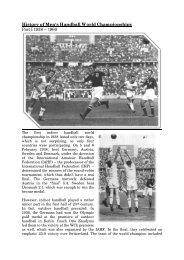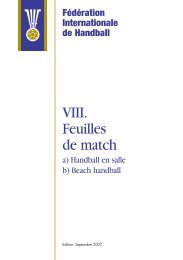LET'S PLAY MINI-HANDBALL - IHF
LET'S PLAY MINI-HANDBALL - IHF
LET'S PLAY MINI-HANDBALL - IHF
You also want an ePaper? Increase the reach of your titles
YUMPU automatically turns print PDFs into web optimized ePapers that Google loves.
PRACTISING GUIDE OF THE<br />
INTERNATIONAL <strong>HANDBALL</strong> FEDERATION<br />
LET’S <strong>PLAY</strong> <strong>MINI</strong>-<strong>HANDBALL</strong><br />
PUBLISHED BY THE COMMISSION FPR PROMOTION AND PUBLIC<br />
RELATIONS (CPP) OF THE INTERNATIONAL <strong>HANDBALL</strong> FEDERATION<br />
PRACTISING GUIDE OF THE<br />
INTERNATIONAL <strong>HANDBALL</strong> FEDERATION<br />
LET’S <strong>PLAY</strong><br />
<strong>MINI</strong>-<strong>HANDBALL</strong><br />
WEB: WWW.<strong>IHF</strong>.INFO • MAIL: <strong>IHF</strong>.OFFICE@<strong>IHF</strong>.INFO
LET’S <strong>PLAY</strong> <strong>MINI</strong>-<strong>HANDBALL</strong> LET’S <strong>PLAY</strong> <strong>MINI</strong>-<strong>HANDBALL</strong><br />
IMPRINT • IMPRESSION • IMPRESSUM<br />
AUTHOR: Steen Hjorth<br />
TRANSLATIONS: Said Bouamra, Michel Pape<br />
LAYOUT: Thorsten Krybus<br />
PRINTING: Graphische Beriebe Holterdorf<br />
PUBLISHED BY THE<br />
Commission for Promotion and Public Relations (CPP)<br />
of the International Handball Federation<br />
Peter-Merian Str. 23<br />
4052 Basel<br />
Switzerland<br />
WEB: www.ihf.info • Mail: ihf.office@ihf.info<br />
GB Contents F Sommaire D Inhalt<br />
PREFACE • PREFACE • VORWORT 04-05<br />
What is Mini-Handball? • Qu’est-ce que le Mini Handball? • Was ist Mini-Handball? 06-07<br />
Philosophy I • Philosophie I • Philosphie I 08-13<br />
Philosophy II • Philosophie II • Philosphie II 14-17<br />
Philosophy III • Philosophie III • Philosphie III 18-19<br />
The Rules of the game • Les Règles du jeu • Die Spielregeln 20-23<br />
Rule test • Test sur les Règles • Regeltest 24-25<br />
Mini-Handball Training • Mini-Handball Entraînement • Mini-Handball Training 26-35<br />
Training advices • Comment organiser l’entraînement • Ratschläge für das Training 36-37<br />
Organisation of training • Organiser l’entraînement • Trainingsorganisation 38-43<br />
Mini-Handball Festival • Festival Mini-Handball • Mini-Handball Festival 44-47<br />
INTERNATIONAL <strong>HANDBALL</strong><br />
INTERNATIONAL <strong>HANDBALL</strong><br />
02 FEDERATION<br />
FEDERATION<br />
03
LET’S <strong>PLAY</strong> <strong>MINI</strong>-<strong>HANDBALL</strong> LET’S <strong>PLAY</strong> <strong>MINI</strong>-<strong>HANDBALL</strong><br />
Carin Nilsson Green<br />
President of the Commission for Promotion and Public Relations<br />
Présidente de la Commission pour le Développement et les Relations publiques<br />
Präsidentin der Kommission für Entwicklung und Öffentlichkeitsarbeit<br />
INTERNATIONAL <strong>HANDBALL</strong> FEDERATION<br />
MAY 2009<br />
GB Preface<br />
The booklet ” Let’s Play Mini-Handball” is an introduction<br />
of Handball for teachers, coaches and parents.<br />
Here you can find an easy and playful way to<br />
start training and games for children.<br />
All the exercises are adapted to children’s physical,<br />
psychological and social capability. Here you will<br />
find the Philosophy of Mini-Handball, how to organise<br />
the practise and the games, simplified rules<br />
and how to organise a Mini-Handball festival.<br />
Mini-Handball can be played indoors as well as outdoors-<br />
on grounds, streets and on the beaches.It’s<br />
easy to start, it’s fun and it gives the children positive<br />
experiences of Handball.<br />
I am very grateful to Steen Hjorth, member of the<br />
<strong>IHF</strong> Commission for Promotion and Public Relations<br />
for elaborating and compiling the contents of this<br />
booklet. <br />
F Préface D Vorwort<br />
La brochure « Let’s Play Mini-Handball » est une introduction<br />
au handball pour les formateurs, entraîneurs<br />
et parents. Vous y trouverez un moyen simple<br />
et amusant pour commencer l’entraînement et les<br />
matches pour les enfants.<br />
Tous les exercices sont adaptés aux capacités physiques,<br />
psychiques et sociales des enfants. Vous découvrirez<br />
ici la philosophie du mini-handball, la manière<br />
d’organiser les entraînements et les matches,<br />
des Règles simplifiées et comment organiser un<br />
festival de mini-handball. Le mini-handball peut<br />
être pratiqué en intérieur comme en extérieur, dans<br />
les rues et sur les plages. C’est facile de débuter,<br />
c’est amusant et fournit aux enfants des expériences<br />
positives de handball.<br />
Je suis très reconnaissante à Steen Hjorth, membre<br />
de la Commission de l’<strong>IHF</strong> pour le Développement<br />
et les Relations publiques pour le recueil et l’élaboration<br />
du contenu de cette brochure.<br />
Die vorliegende Broschüre “Let’s Play Mini-Handball”<br />
ist eine Einführung zum Thema Handball und<br />
richtet sich an Lehrer, Trainer und Eltern. Sie bietet<br />
einen einfachen und spielerischen Einstieg in das<br />
Training und das Spiel für Kinder.<br />
Alle Übungen sind speziell auf die physischen, mentalen<br />
und sozialen Fähigkeiten von Kindern abgestimmt.<br />
Zu finden ist hier die Philosophie des Mini-<br />
Handballs,Tipps zur Organisation und Durchführung<br />
des Trainings und der Spiele, vereinfachte Regeln<br />
und eine praktische Anleitung zur Gestaltung eines<br />
Mini-Handball Festivals. Dabei kann Mini-Handball<br />
sowohl in der Halle, als auch draußen gespielt werden,<br />
auf Sportplätzen, auf der Straße und am<br />
Strand. Es ist leicht zu beginnen, es macht Spaß und<br />
gibt den Kindern positive Erfahrungen im Handball<br />
Ich danke Steen Hjorth, Mitglied der Kommission<br />
für Entwicklung und Öffentlichkeitsarbeit der <strong>IHF</strong>,<br />
für seine Ausführungen und die Zusammenstellung<br />
dieses Buches. <br />
INTERNATIONAL <strong>HANDBALL</strong><br />
INTERNATIONAL <strong>HANDBALL</strong><br />
04 FEDERATION<br />
FEDERATION<br />
05
LET’S <strong>PLAY</strong> <strong>MINI</strong>-<strong>HANDBALL</strong> LET’S <strong>PLAY</strong> <strong>MINI</strong>-<strong>HANDBALL</strong><br />
GB What is <strong>MINI</strong>-<strong>HANDBALL</strong>? F Qu’est-ce que le <strong>MINI</strong> <strong>HANDBALL</strong>? D Was ist <strong>MINI</strong>-<strong>HANDBALL</strong>?<br />
Mini-handball...<br />
• ...is a game<br />
• a special philosophy<br />
• special equipment<br />
• special rules<br />
• adapted to children up to 8-9 years<br />
...is Mini-Handball training<br />
• training more important than matches<br />
• fun, high activity<br />
• enthusiastic coaches<br />
• varied training adapted to the children<br />
...is Mini-Handball Festivals<br />
• a positive experience with sport<br />
• mini-handball and other adapted activities<br />
...is a possibility to involve adults<br />
• as coaches<br />
• as parents<br />
(supporters – to the child, to the coach, to the club..)<br />
Le mini handball est...<br />
...un jeu avec<br />
• une philosophie spéciale<br />
• un équipement spécial<br />
• des Règles spéciales<br />
• adapté à des enfants de 8-9 ans<br />
...l’entraînement du mini handball<br />
• l’entraînement est plus important que les matches<br />
• amusant avec une grande activité<br />
• des entraîneurs passionnés et enthousiastes<br />
• un contenu varié, adapté aux enfants<br />
...les festivals de mini handball<br />
• sont une expérience positive pour le sport.<br />
• pour le mini handball lui-même et pour les autres activités.<br />
...une possibilité d´impliquer des adultes<br />
• comme entraîneurs,<br />
• comme les parents (supporters, de l’enfant, de<br />
l’entraîneur, du club….)<br />
Mini-Handball...<br />
...ist ein Spiel<br />
• eine besondere Philosophie<br />
• spezielle Ausrüstung<br />
• spezielle Regeln<br />
• ausgerichtet auf Kinder im Alter von 8-9 Jahren<br />
...ist Mini-Handball Training<br />
• Training ist wichtiger als das Spiel gegeneinander<br />
• Spaß, hohes Maß an Aktivität<br />
• begeisterte Trainer<br />
• vielseitiges, kindgerechtes Training<br />
...Mini-Handball Festivals<br />
• eine positive Erfahrung in Verbindung mit Sport<br />
• Mini-Handball und weitere geeignete Aktivitäten<br />
• Möglichkeiten, Erwachsene einzubeziehen<br />
• als Trainer<br />
• als Eltern (zur Unterstützung –<br />
für das Kind, den Trainer, den Verein)<br />
INTERNATIONAL <strong>HANDBALL</strong><br />
INTERNATIONAL <strong>HANDBALL</strong><br />
06 FEDERATION<br />
FEDERATION<br />
07
LET’S <strong>PLAY</strong> <strong>MINI</strong>-<strong>HANDBALL</strong><br />
GB <strong>MINI</strong>-<strong>HANDBALL</strong> – Philosophy I<br />
Mini-Handball - is a game which is adapted to children up to 8-9 years.<br />
Obviously, not the children are adapted to a complete game, but the game to the children. They play on smaller fields of play, with smaller goals,<br />
with a smaller ball, and with rules the children are able to understand.<br />
Mini-Handball - is a game for children to start with sport, focussing on their natural movements.<br />
• Running<br />
• Throwing<br />
• Catching<br />
• Hopping on one foot<br />
• Balancing<br />
• Playing alone<br />
• Jumping<br />
• Walking<br />
• Jumping around<br />
• Rotating<br />
• Dribbling<br />
• Playing together with other children<br />
LET’S <strong>PLAY</strong> <strong>MINI</strong>-<strong>HANDBALL</strong><br />
Mini-Handball - is a game which satisfies the children’s natural needs for movement.<br />
The mini-handball training is organised is such a way that the children get to learn the handball game through<br />
games. It is important that the children are in active all the time – and that each child gets to play as much with<br />
the ball as possible.<br />
Mini-Handball - is a game which provides experience by playing where the result<br />
of a match is not the most important thing.<br />
1 2<br />
During the training as well as at special mini-handball<br />
festivals, the children play matches. The purpose of<br />
these matches is to give the children the possibility to<br />
test their skills. The match must be a positive experience<br />
– no matter if you win or lose!<br />
Therefore the single match is important, there will be<br />
no “counting of points” to determine a final winner.<br />
Mini-Handball - is a game trying to<br />
motivate little children to continuous<br />
physical activity.<br />
Assuming that a good and positive experience in<br />
connection with a child’s first acquaintance with<br />
sport will motivate it to many years of continuous<br />
participation in sport, the association tries to create<br />
good conditions regarding the child’s start in sports.<br />
1<br />
Jump and shoot<br />
Sauter et lancer<br />
Springen und werfen<br />
2<br />
Concentrate and score<br />
Se concentrer et marquer<br />
Konzentrieren und treffen<br />
INTERNATIONAL <strong>HANDBALL</strong><br />
INTERNATIONAL <strong>HANDBALL</strong><br />
08 FEDERATION<br />
FEDERATION<br />
09
LET’S <strong>PLAY</strong> <strong>MINI</strong>-<strong>HANDBALL</strong><br />
F <strong>MINI</strong>-<strong>HANDBALL</strong> – Philosophie I<br />
Mini-Handball - • C’est un jeu qui est adapté aux enfants de 8-9 ans.<br />
Evidemment, il ne s’agit pas d’un handball classique adapté aux enfants, mais d’un jeu pour les enfants. Ces derniers jouent dans de petits<br />
espaces avec de petits buts, selon des Règles qu’ils sont capables de comprendre.<br />
Mini-Handball - C’est un jeu pour les enfants qui débutent dans le sport, mettant en valeur des mouvements<br />
naturels.<br />
• Courir<br />
• Lancer<br />
• Attraper<br />
• Sautiller sur un pied<br />
• S’équilibrer<br />
• Jouer seul<br />
• Sauter<br />
• Marcher<br />
• Sauter en tournant<br />
• Pivoter<br />
• Dribbler<br />
• Jouer avec d’autres enfants<br />
3<br />
LET’S <strong>PLAY</strong> <strong>MINI</strong>-<strong>HANDBALL</strong><br />
Mini-Handball - C’est un jeu qui répond aux besoins des mouvements naturels des<br />
enfants.<br />
L’entraînement de mini handball est organisé de telle sorte que les enfants apprennent à jouer au handball au moyen<br />
de jeux. Il est important que les enfants soient en activité constante et que chacun d’eux puisse jouer avec la balle<br />
le plus longtemps possible.<br />
Mini-Handball - C’est un jeu qui apporte une expérience en jouant et où le résultat<br />
du match n’est pas important.<br />
Durant l’entraînement, aussi bien que lors des festivals spéciaux<br />
de mini handball, les enfants jouent des matches. Le<br />
but de ces derniers est de donner aux enfants la possibilité<br />
de tester leur adresse (leur habilité). Le match doit une expérience<br />
positive, peu importe si vous gagnez ou perdez. Le<br />
match en lui-même est important, cependant le total des<br />
points ne déterminera pas le gagnant final.<br />
3<br />
Protect the ball<br />
Protéger le ballon<br />
Den Ball abschirmen<br />
4<br />
Give and go!!!<br />
Passer et partir!!!<br />
Doppelpass!!!<br />
INTERNATIONAL <strong>HANDBALL</strong><br />
INTERNATIONAL <strong>HANDBALL</strong><br />
10 FEDERATION<br />
FEDERATION<br />
11<br />
4<br />
Mini-Handball - Le mini handball est un jeu<br />
qui essaie de motiver les jeunes enfants pour la<br />
pratique régulière d’une activité physique.<br />
En admettant que c’est une bonne et positive expérience<br />
pour l’enfant dans sa première découverte du<br />
sport, ceci le motivera pour l’avenir à pratiquer régulièrement<br />
cette discipline. L’association essaiera dès le<br />
début de la pratique sportive de l’enfant de créer de<br />
bonnes conditions pour son épanouissement.
LET’S <strong>PLAY</strong> <strong>MINI</strong>-<strong>HANDBALL</strong><br />
D <strong>MINI</strong>-<strong>HANDBALL</strong> – Philosophie I<br />
Mini-Handball - ist eine Spielform, die sich an Kinder im Alter von 8-9 Jahren richtet.<br />
Offenkundig sollte sich das Spiel an die Bedürfnisse der Kinder anpassen und nicht die Kinder an die Erfordernisse des Spiels. Gespielt wird auf<br />
einem kleineren Spielfeld, mit kleineren Toren, einem kleineren Ball und mit Regeln, die für Kinder leicht verständlich sind.<br />
Mini-Handball - ist ein Spiel für Kinder als Einstieg in sportliche Aktivitäten, welches sich auf den natürlichen<br />
Bewegungsablauf konzentriert.<br />
• Laufen<br />
• Werfen<br />
• Fangen<br />
• Hüpfen auf einem Bein<br />
• Balancieren<br />
• Spiel mit dem Ball (alleine)<br />
• Hüpfen<br />
• Gehen<br />
• Herumspringen<br />
• Drehen<br />
• Dribbeln<br />
• Zusammenspiel mit anderen Kindern<br />
Sowohl während des Trainings als auch bei speziellen<br />
Mini-Handball Festivals spielen die Kinder auch gegeneinander.<br />
Der Hintergrund dieser Spiele ist es, den Kin-<br />
LET’S <strong>PLAY</strong> <strong>MINI</strong>-<strong>HANDBALL</strong><br />
Mini-Handball - ist ein Spiel, welches sich am natürlichen Bewegungsdrang der<br />
Kinder orientiert.<br />
Das Mini-Handball Training ist darauf ausgerichtet, die Sportart Handball spielerisch zu erlernen. Dabei ist es von<br />
besonderer Bedeutung, den Kindern permanent Aktivitäten zu bieten und das Spiel mit dem Ball so oft wie möglich<br />
zu praktizieren.<br />
Mini-Handball - ist eine Spielform, deren Erfahrung durch das Spielen selbst<br />
geprägt wird, wobei der Ausgang des Wettkampfes eher unwichtig ist.<br />
51 6<br />
Der Zweck des Spiels ist es die Möglichkeit zu bieten,<br />
ihre Fähigkeiten untereinander messen zu können. Das<br />
Kräftemessen sollte immer eine positive Erfahrung sein<br />
– egal ob man gewinnt oder verliert! Daher sollten nur<br />
die einzelnen Spiele wichtig sein. Es sollten keine Siege<br />
„aufaddiert“ werden, die einen abschließenden Gewinner<br />
bestimmen.<br />
Mini-Handball - ist eine Spielform, die<br />
Kinder dazu animiert, sich dauerhaft<br />
körperlich zu betätigen.<br />
Geht man davon aus, dass positive Erfahrungen im Zusammenhang<br />
mit körperlicher Aktivität bei Kindern eine<br />
dauerhafte Motivation, sich dauerhaft sportlich zu<br />
betätigen nach sich ziehen, so bildet diese Assoziation<br />
auch die Grundlage für einen Start in ein sportlich aktives<br />
Leben. <br />
5<br />
Catch and play<br />
Attraper et jouer<br />
Annehmen und weiter<br />
spielen<br />
6<br />
Concentrate and catch<br />
Se concentrer et attraper<br />
Konzentrieren und<br />
annehmen<br />
INTERNATIONAL <strong>HANDBALL</strong><br />
INTERNATIONAL <strong>HANDBALL</strong><br />
12 FEDERATION<br />
FEDERATION<br />
13
LET’S <strong>PLAY</strong> <strong>MINI</strong>-<strong>HANDBALL</strong><br />
GB <strong>MINI</strong>-<strong>HANDBALL</strong> – The Philosophy II<br />
• Mini-handball is more a philosophy than a game.<br />
• In many countries mini-handball has developed rapidly<br />
as an activity for the youngest children<br />
(from 5-6 years to 8-9 years).<br />
• Mini-handball is a kind of education in sport for the<br />
youngest.<br />
• Only a few and very simplified rules allow all<br />
participants a lot of freedom.<br />
• Mini-handball is a suitable activity for both primary<br />
schools and clubs.<br />
• The emphasis is put on playing (having fun).<br />
• Neither tactics nor ”winning” are of great importance.<br />
• The philosophy of mini-handball reflects the children’s<br />
pleasure and their experiences when playing a ball game.<br />
• The court, the balls and the goals are adapted to the<br />
age of the children; the technique of playing is based<br />
on the motor skills of children 6-8 years.<br />
• Positive experiences will support the development of a<br />
child’s playing behaviour.<br />
• Playing and practising are organised in the form of a<br />
game, both following pedagogic and methodological<br />
principles; the role of the coach is limited to only<br />
supervise and help when necessary. When playing<br />
matches, there is no referee – but a supervisor, who<br />
teaches and helps the children during the play.<br />
• Fairness is very important in the philosophy of<br />
mini-handball.<br />
• Boys and girls will learn to act in a group, accepting<br />
their own merits and shortcomings and those of others.<br />
• Mini-handball contains a lot of rudimentary elements<br />
of other sports or sometimes even creates them.<br />
1<br />
LET’S <strong>PLAY</strong> <strong>MINI</strong>-<strong>HANDBALL</strong><br />
7<br />
Shoot and score<br />
Lancer et marquer<br />
Werfen und treffen<br />
INTERNATIONAL <strong>HANDBALL</strong><br />
INTERNATIONAL <strong>HANDBALL</strong><br />
14 FEDERATION<br />
FEDERATION<br />
15<br />
7
LET’S <strong>PLAY</strong> <strong>MINI</strong>-<strong>HANDBALL</strong> LET’S <strong>PLAY</strong> <strong>MINI</strong>-<strong>HANDBALL</strong><br />
F <strong>MINI</strong>-<strong>HANDBALL</strong> – Philosophie II<br />
• Le mini handball est plus une philosophie qu’un jeu.<br />
• Dans plusieurs pays le mini handball s’est développé<br />
rapidement comme une activité pour les jeunes enfants<br />
(de 5-6 ans à 8-9 ans).<br />
• Le mini handball est une forme d’éducation au sport<br />
pour les plus jeunes.<br />
• La simplicité des Règles offre à tous les participants une<br />
plus grande liberté.<br />
• Le mini handball est une activité qui convient à la fois<br />
aux écoles primaires et aux clubs.<br />
• L´accent est mis sur le jeu.<br />
• Ni les tactiques, ni les victoires ne sont d’une grande<br />
importance.<br />
• La philosophie du mini handball reflète à la fois le<br />
plaisir des enfants et leurs expériences du jeu avec un ballon.<br />
• Le terrain de jeu, les balles et les buts sont adaptés à<br />
l’âge des enfants. La technique du jeu est basée sur<br />
les capacités motrices des enfants de 6-8 ans.<br />
• Les expériences positives seront le support du développement<br />
comportemental de l’enfant durant le jeu.<br />
• La pratique du jeu est organisée sous forme ludique,<br />
1<br />
suivant à la fois les principes pédagogiques et méthodologiques.<br />
Le rôle de l’entraîneur est limité uniquement à<br />
encadrer et conseiller si nécessaire. Lors des matches, il<br />
n’y a pas d’arbitre, mais un superviseur qui dirige et<br />
aide les enfants pendant le jeu.<br />
• L´équité occupe une place importante dans la<br />
philosophie du mini handball.<br />
• Les garçons et les filles apprendront à jouer ensemble,<br />
tout en acceptant leurs propres valeurs et défauts et<br />
ceux des autres.<br />
• Le mini handball renferme beaucoup d’éléments<br />
rudimentaires des autres sports et parfois même les crée.<br />
D <strong>MINI</strong>-<strong>HANDBALL</strong> – Philosophie II<br />
• Mini-Handball ist mehr eine Philosophie als ein Spiel.<br />
• In vielen Ländern hat sich Mini-Handball schnell zur<br />
Aktivität für die Jüngsten entwickelt (von 5-6 Jahren bis<br />
zu 8-9 Jahren).<br />
• Mini-Handball ist eine Art von sportlicher Erziehung.<br />
• Wenige und vereinfachte Regeln erlauben ein Höchstmaß<br />
an Freiheit.<br />
• Mini-Handball ist eine eignet sich als Aktivität sowohl<br />
für Grundschulen als auch für Vereine.<br />
• Der Schwerpunkt liegt auf dem spielerischen Aspekt<br />
(Es soll Spaß machen).<br />
• Weder die Taktik noch das „Gewinnen“ sind von<br />
Bedeutung.<br />
• Die Philosophie des Mini-Handballs spiegelt die Freude<br />
des Kindes am Spiel mit dem Ball wieder.<br />
• Das Spielfeld, der Ball und die1Tore sind dem Alter der<br />
Kinder angepasst. Die Spieltechnik basiert auf den<br />
motorischen Fähigkeiten von Kindern im Alter von 6-8 Jahren.<br />
• Postiive Erfahrungen unterstützen die Entwicklung des<br />
Verhaltens der Kinder im Spiel.<br />
• Spiele und Übungsformen sind spielerisch angelegt, wo<br />
bei diese pädagogischen und methodischen Prinzipien<br />
folgen. Die Rolle des Trainers beschränkt sich auf<br />
Aufsicht und, sofern benötigt, Hilfestellung. Bei der<br />
Durchführung von Spielen von Mannschaften gegeneinander<br />
gibt es keinen Schiedsrichter, sondern einen<br />
Supervisor, der die Kinder anleitet und während des<br />
Spiels helfend eingreift.<br />
• Fairness ist für die Philosphie des Mini-Handballs sehr<br />
wichtig.<br />
• Jungen und Mädchen lernen, in der Gruppe zu agieren,<br />
Leistungen bei sich und anderen anzuerkennen und<br />
eigene Grenzen zu akzeptieren.<br />
• Mini-handball beinhaltet die Grundelemente vieler<br />
anderer Sportarten und legt diese oft sogar als erstes an.<br />
INTERNATIONAL <strong>HANDBALL</strong><br />
INTERNATIONAL <strong>HANDBALL</strong><br />
16 FEDERATION<br />
FEDERATION<br />
17
LET’S <strong>PLAY</strong> <strong>MINI</strong>-<strong>HANDBALL</strong> <strong>MINI</strong>-LET’S <strong>PLAY</strong> <strong>HANDBALL</strong><br />
GB <strong>MINI</strong>-<strong>HANDBALL</strong> – Philosophy III F <strong>MINI</strong>-<strong>HANDBALL</strong> – Philosop hie III D <strong>MINI</strong>-<strong>HANDBALL</strong> – Philosophie III<br />
• Increased pressure results<br />
in violence and aggressiveness<br />
on the field of play<br />
• L’augmentation de la<br />
pression engendre la<br />
violence et l’agressivité<br />
sur le terrain de jeu<br />
• Ein zu hoher Druck resultiert<br />
in Gewalt und aggressivem<br />
Verhalten auf dem Spielfeld.<br />
• First the performer<br />
(the child) – then wining<br />
the game<br />
• En premier le performant<br />
(l’enfant) En second la<br />
victoire (le jeu)<br />
• Wichtig sind die Akteure<br />
(die Kinder) und nicht die<br />
Siege.<br />
• Give the children the possibility<br />
to try different kinds<br />
of sports with different<br />
possibilities of movements<br />
• Donner aux enfants la<br />
possibilité d’essayer<br />
différents sports ainsi que<br />
différentes variétés de<br />
mouvements<br />
• Gibt den Kindern die Möglichkeit,<br />
verschiedene Sportarten<br />
mit unterschiedlichen<br />
Bewegungsformen auszuprobieren.<br />
• Organise training as game<br />
• Organiser l’entraînement<br />
comme un jeu<br />
• Organisiere das Training<br />
als Spiel.<br />
• Avoid comprehensive<br />
competitions for children<br />
under 10 years<br />
• Eviter des compétitions<br />
trop compliquées pour les<br />
enfants de moins de 10 ans<br />
• Für Kindern unter 10 Jahren<br />
machen Wettkämpfe keinen<br />
Sinn.<br />
• Avoid early specialisation<br />
• Eviter une spécialisation<br />
précoce<br />
• Vermeide eine zu frühe<br />
Spezialisierung.<br />
• Encourage friendship<br />
during training and<br />
competition<br />
• Encourager l’amitié durant<br />
l’entraînement et la<br />
compétition<br />
• Stärkt die Freundschaft bei<br />
Training und Wettbewerb.<br />
• The<br />
1<br />
ambitions of the<br />
parents are often the<br />
motive of the children<br />
• Les ambitions des parents<br />
motivent souvent les<br />
enfants<br />
• Die Ambitionen der Eltern<br />
sind oft die Motive der<br />
Kinder.<br />
INTERNATIONAL <strong>HANDBALL</strong><br />
INTERNATIONAL <strong>HANDBALL</strong><br />
18 FEDERATION<br />
FEDERATION<br />
19
LET’S <strong>PLAY</strong> <strong>MINI</strong>-<strong>HANDBALL</strong> LET’S <strong>PLAY</strong> <strong>MINI</strong>-<strong>HANDBALL</strong><br />
GB <strong>MINI</strong>-<strong>HANDBALL</strong> – The Rules of the game<br />
• for boys and girls up to 8-9 years<br />
• Pour les garçons et les filles jusqu´à 8-9 ans<br />
• für Jungen und Mädchen bis zum Alter von 8-9 Jahren<br />
• 5 players on the court – 2 boys and 2 girls and 1 goalkeeper (boy or girl)<br />
• 5 joueurs sur le terrain – 2 garçons + 2 filles et un gardien de but<br />
(garçon ou fille)<br />
• 5 Spieler auf dem Feld – Zwei Jungen, zwei Mädchen und ein Torwart<br />
(Junge oder Mädchen)<br />
• Size of the goal: 240 cm x 160 cm<br />
• Dimensions du but : 240 cm x160 cm<br />
• Größe des Tors: 240 cm x 160 cm<br />
• Size of the ball: 46-48 cm – 225-275 gr. Other balls can be used.<br />
• Dimensions de la balle : 46-48 cm, 225-275 g. D´autres balles peuvent<br />
également être utilisées<br />
• Größe des Balls: 46-48 cm – 225-275 gr. Andere Bälle können ebenfalls<br />
benutzt werden.<br />
• Size of the court: see p. 20 and 23<br />
• Dimensions du terrain: voir p. 20 et 23<br />
• Größe des Spielfeldes: siehe Grafik S. 20 und S.23<br />
• The handball rules are the basis of mini-handball, but the rules<br />
regarding technical faults shall be assessed according to the age and the<br />
skills of the children participating in the game<br />
• Les Règles fondamentales du handball sont applicables au mini-handball.<br />
Cependant, les Règles concernant les fautes techniques seront adaptées<br />
suivant l’âge et l’habilité des enfants qui participent au jeu<br />
• Die normalen Handballregeln sind die Basis des Mini-Handballs, allerdings<br />
sollten die Regeln bezüglich technischer Fehler passend zum Alter und den<br />
Fähigkeiten der Kinder, die am Spiel teilnehmen, ausgelegt werden<br />
F <strong>MINI</strong>-<strong>HANDBALL</strong> – Les Règles de jeu D <strong>MINI</strong>-<strong>HANDBALL</strong> – Die Spielregeln<br />
13m<br />
20m<br />
Block and defend<br />
Bloquer et défendre<br />
Sperren und verteidigen<br />
INTERNATIONAL <strong>HANDBALL</strong><br />
INTERNATIONAL <strong>HANDBALL</strong><br />
20 FEDERATION<br />
FEDERATION<br />
21<br />
8<br />
8
LET’S <strong>PLAY</strong> <strong>MINI</strong>-<strong>HANDBALL</strong> LET’S <strong>PLAY</strong> <strong>MINI</strong>-<strong>HANDBALL</strong><br />
GB <strong>MINI</strong>-<strong>HANDBALL</strong> – The Rules of the game F <strong>MINI</strong>-<strong>HANDBALL</strong> – Les Règles de jeu D <strong>MINI</strong>-<strong>HANDBALL</strong> – Die Spielregeln<br />
• All deliberate physical contact between the players shall be avoided.<br />
• Tout contact physique délibéré entre les joueurs sera à éviter.<br />
• Jeder absichtliche Körperkontakt zwischen Spielern sollte unterbunden werden.<br />
• In some countries, defence is only allowed in the area between the goal-area<br />
line (4,5 m) and the free-throw line (5,5 m) (read area) – if there is no freethrow<br />
line, a line) can be made 5,5 m from the outer goal line, and then it is<br />
allowed to defend in this area (green area). In other countries it is allowed to<br />
defend all over the court – except for the two goal areas.<br />
• Dans certains pays, la défense est seulement admise dans la surface comprise<br />
entre la ligne de surface de but (4,5m) et la ligne de jet franc (5,5m). S’il n’y a<br />
pas de ligne de jet franc, une ligne) de 5,5m peut être tracée à<br />
l’extérieur de laligne de but (zone verte). Dans d’autres pays, il est<br />
admis de défendre sur tout le terrain, excepté dans les 2 zones de but.<br />
• In einigen Ländern ist die Abwehr nur im Bereich zwischen dem Torraumlinie<br />
(4,5 m) und der Freiwurflinie (5,5 m) erlaubt. Falls keine Freiwurflinie vorhanden<br />
ist, kann eine solche) 5,5 m von der äußeren Torlinie angelegt<br />
werden. Somit ist die Abwehr in dieser Zone erlaubt (grüne Fläche). In<br />
anderen Ländern ist die Abwehr über das ganze Spielfeld mit Ausnahme der<br />
beiden Torräume erlaubt.<br />
9<br />
9<br />
Focus on scoring<br />
Se concentrer pour marquer<br />
Das Tor im Blick<br />
Play fair<br />
Jouer de manière fair play<br />
Fair-Play<br />
INTERNATIONAL <strong>HANDBALL</strong><br />
INTERNATIONAL <strong>HANDBALL</strong><br />
22 FEDERATION<br />
FEDERATION<br />
23<br />
10<br />
• By playing mini-handball the children<br />
learn to understand and to accept<br />
playing according to rules.<br />
• En jouant au mini-handball, les enfants<br />
apprennent, comprennent et acceptent<br />
les Règles.<br />
• Durch Mini-Handball lernen die Kinder,<br />
Regeln im Spiel zu verstehen und zu<br />
akzeptieren.<br />
• In a mini-handball match there is no<br />
referee - but a supervisor, who<br />
teaches and helps the children to<br />
understand the rules and the game.<br />
• Dans un match de mini-handball, il n’y<br />
a pas d’arbitre mais un superviseur qui<br />
dirige et aide les enfants à comprendre<br />
les Règles et le jeu.<br />
• In einem Mini-Handball-Spiel gibt es<br />
keinen Schiedsrichter - sondern einen<br />
Supervisor, der unterrichtet und den<br />
Kindern die Spielregeln beibringt<br />
10
LET’S <strong>PLAY</strong> <strong>MINI</strong>-<strong>HANDBALL</strong> LET’S <strong>PLAY</strong> <strong>MINI</strong>-<strong>HANDBALL</strong><br />
GB <strong>MINI</strong>-<strong>HANDBALL</strong> – Rule test F <strong>MINI</strong>-<strong>HANDBALL</strong> – Test sur les Règles D <strong>MINI</strong>-<strong>HANDBALL</strong> – Regelkunde<br />
1<br />
2<br />
3<br />
4<br />
5<br />
6<br />
7<br />
8<br />
9<br />
10<br />
11<br />
12<br />
13<br />
How many players are allowed on the court at the same time<br />
(in the same team)?<br />
Combien de joueurs sont admis sur le terrain en même temps ?<br />
(dans une même équipe)<br />
Wie viele Spieler dürfen gleichzeitg auf dem Spielfeld sein?<br />
(im selben Team)<br />
Are boys and girls allowed to play in the same mini-handball-team?<br />
Les filles et les garçons sont-ils autorisés à jouer dans une même<br />
équipe de mini handball ?<br />
Dürfen Jungen und Mädchen in einer Manschaft spielen?<br />
What is the correct judgement if a defence player pushes an<br />
Quelle est la décision correcte si un joueur défenseur pousse un Was ist die korrekte Entscheidung, wenn ein Abwehrspieler einen<br />
attack player?<br />
joueur attaquant ?<br />
angreifenden Spieler wegstößt?<br />
What is the correct judgement if a player drops the ball over the Quelle est la décision correcte si un joueur laisse tomber la balle au Was ist die korrekte Entscheidung, wenn ein Spieler den Ball über<br />
sideline?<br />
delà de la ligne de touche ?<br />
1<br />
die Seitenlinie wirft?<br />
How old is a mini-handball player? Quel est l’âge maximum d’un joueur de mini-handball ? Wie alt sind die Spieler beim Mini-Handball?<br />
Is the correct judgement to always whistle if a mini-handball<br />
player goes 4 steps with the ball?<br />
Do you always start with the ball in the middle of the court after<br />
scoring in a mini-handball match?<br />
Faut-il toujours siffler lorsqu’un joueur de mini-handball fait 4 pas<br />
avec la balle ?<br />
Durant un match de mini-handball, faut-il toujours repartir avec la<br />
balle du centre du terrain après qu’un but soit marqué ?<br />
Muss immer gepfiffen werden, wenn ein Spieler beim Mini-Handball<br />
mehr als vier Schritte mit dem Ball macht?<br />
Wird das Spiel immer mit dem Ball von der Mittellinie fortgesetzt,<br />
nachdem ein Tor gefallen ist?<br />
What is the size of a mini-handball court? Quelles sont les dimensions d’un terrain de mini-handball ? Welche Abmessungen hat ein Spielfeld beim Mini-Handball?<br />
Is it allowed to replace a male goalkeeper with a female one<br />
(and vice versa)?<br />
Est-il admis de remplacer un gardien de but masculin par un autre<br />
féminin (et vice versa) ?<br />
Ist es erlaubt, einen Jungen im Tor mit einem Mädchen (und<br />
umgekehrt) zu ersetzten.<br />
What is the size of a mini-handball goal? Quelles sont les dimensions d’un but de mini-handball ? Wie groß ist ein Tor beim Mini-Handball?<br />
Is the referee in a mini-handball match dressed in black?<br />
Est-ce que l’arbitre lors d’un match de mini-handball est habillé en<br />
noir ?<br />
Ist der Schiedsrichter beim Mini-Handball schwarz gekleidet?<br />
Do mini-handball players play with a junior ball? En mini-handball, les joueurs peuvent-ils jouer avec un ballon junior ? Spielt man Mini-Handball mit einem Handball für Junioren?<br />
Is it correct to always whistle if a mini-handball player holds the<br />
ball for 5 seconds?<br />
En mini-handball, faut-il toujours siffler lorsqu’un joueur garde le<br />
ballon 5 secondes ?<br />
Ist es richtig, zu pfeifen, wenn ein Spieler den Ball beim Mini-Handball<br />
mehr als 5 Sekunden in den Händen hält?<br />
1<br />
A B C<br />
7 5 8<br />
Yes • Oui • Ja No • Non • Nein ?<br />
INTERNATIONAL <strong>HANDBALL</strong><br />
INTERNATIONAL <strong>HANDBALL</strong><br />
24 FEDERATION<br />
FEDERATION<br />
25<br />
Nothing<br />
Aucune<br />
Nichts<br />
Goal<br />
But<br />
Tor<br />
Up till 8 years<br />
Plus de 8ans<br />
Tor<br />
Penalty<br />
Pénalty<br />
7-Meter<br />
Throw in<br />
Remise en jeu<br />
Einwurf<br />
9-10 years<br />
9-10 ans<br />
9-10 Jahre<br />
Free throw<br />
Jet franc<br />
Freiwurf<br />
Nothing<br />
Aucune<br />
Nichts<br />
Older than 11 years<br />
Plus de 11ans<br />
Älter als 11 Jahre<br />
No • Non • Nein Yes • Oui • Ja ?<br />
? No • Non • Nein Yes • Oui • Ja<br />
7 x 10 m 13 x 20 m 20 x 40 m<br />
Yes • Oui • Ja ? No • Non • Nein<br />
150 x 200 cm 200 x 300 cm 160 x 240 cm<br />
Yes • Oui • Ja No • Non • Nein ?<br />
No • Non • Nein ? Yes • Oui • Ja<br />
? No • Non • Nein Yes • Oui • Ja<br />
RIGHT ANSWERS<br />
BONNES RÉPONSES<br />
RICHTIGE ANTWORTEN<br />
B<br />
A<br />
B<br />
B<br />
A<br />
A<br />
B<br />
B<br />
A<br />
C<br />
B<br />
A<br />
B
• ROLLING<br />
• CREEPING<br />
• CRAWLING<br />
• WALKING<br />
• RUNNING<br />
• HOPPING ON TWO FEET<br />
• HOPPING ON ONE FOOT<br />
• JUMPING<br />
• BALANCING<br />
• SEESAWING AND SWINGING<br />
• SWINGING AND PULLING<br />
• PUSHING AND PULLING<br />
LET’S <strong>PLAY</strong> <strong>MINI</strong>-<strong>HANDBALL</strong><br />
GB <strong>MINI</strong>-<strong>HANDBALL</strong> - Training<br />
• The basis of mini-handball is to train the motor function development of the individual child participating in<br />
the training.<br />
CRUDE MOTOR FUNCTIONS FINE MOTOR FUNCTIONS 11<br />
• ROLLING WITH SMALL TOOLS<br />
• THROWING AND KICKING<br />
• DRIBBLING WITH THE HANDS<br />
• BOUNCING WITH THE BALL<br />
• DRIBBLING WITH ONE HAND<br />
LET’S <strong>PLAY</strong> <strong>MINI</strong>-<strong>HANDBALL</strong><br />
• In mini-handball training we must be aware of the mental and social development<br />
of small children. It means -<br />
• we must try to stimulate the intellectual development<br />
of the children by involving conceptions of time<br />
and space (over, under, behind, in front of, slow, fast…)<br />
• we must be aware that the language of the children<br />
are under development. Be very concrete (not<br />
abstract) to small children<br />
• we must be aware that little children:<br />
are learning by doing<br />
do not learn from own experiences<br />
do not see the connection between cause and<br />
consequence<br />
are learning through playing a lot of games,<br />
especially with balls<br />
are learning when they have fun<br />
This also means –<br />
• that the training of the intellectual development of<br />
the child gives it better possibilities to act in different<br />
connections (understand, judge and act)<br />
• that parallel to the intellectual development of the<br />
child, we must be aware of the development of the<br />
identity of the child – that means the child’s awareness<br />
and understanding of him- or herself.<br />
• that awareness is developed in the training and the<br />
relation to the coach. Being confident/secure/safe is<br />
important – but also the child’s awareness of his or<br />
her body is important for the development of the<br />
child’s identity.<br />
11<br />
Try your best<br />
Fais de ton mieux<br />
Das Beste geben<br />
INTERNATIONAL <strong>HANDBALL</strong><br />
INTERNATIONAL <strong>HANDBALL</strong><br />
26 FEDERATION<br />
FEDERATION<br />
27
LET’S <strong>PLAY</strong> <strong>MINI</strong>-<strong>HANDBALL</strong> LET’S <strong>PLAY</strong> <strong>MINI</strong>-<strong>HANDBALL</strong><br />
• that having a good awareness of the body is amongst others<br />
depending on if the child can manage to solve the task given to it by<br />
the coach. ”I can solve the task by using my body”.<br />
• that coaches must be aware of the social development of the child –<br />
that is to say the ability to function together with other children<br />
Children 3-4 years old:<br />
• The social development is founded until the child is 3-4 years old.<br />
Aged 3-4 years, it is in the ”selfish stadium”. My needs are the most<br />
important, I want to play – with myself. If the child has to play with<br />
others, ”role play” can be used.<br />
• The participation in games that demand the ability to cooperate<br />
with other children is normally difficult for the child.<br />
Children 5-6 years old:<br />
• This period is characterised as turbulent – with refractoriness and<br />
conflicts.<br />
• The coaches must be aware of it and create surroundings filled with<br />
confidence.<br />
• The coaches must also be aware that they have a great influence on<br />
the development of the child.<br />
• The children can start to play in small groups – but only for a short period.<br />
• Throw ”normally” (rotation in the upper part of the body and<br />
weight on one foot).<br />
• Catch the ball – without pulling the ball to the body. Very often the<br />
child stands still when catching the ball.<br />
• Some children manage to jump on one foot.<br />
• Most children manage to run in different ways.<br />
• Only the most-developed 6-year old children understand some<br />
handball tactics<br />
• Most 5-6-year old children can manage games with 2-3 children in<br />
each team<br />
Children 7 – 8 years old:<br />
• From the age of 7 years on, the child begins to show social beha<br />
viour. Playing in groups becomes interesting. The child can manage<br />
to participate in games with rules to follow.<br />
• 7 – 8-year old children start to think about social questions arising through<br />
interactions with other children. Games with rules are often exciting.<br />
• Most children manage to catch the ball in different ways (hard, soft,<br />
with precision….)<br />
• Most children can run and catch/throw, when they are moving.<br />
• Most children can jump on one or two feet.<br />
• Most children like to compete – also to participate in competitions<br />
against other children <br />
F <strong>MINI</strong>-<strong>HANDBALL</strong> - Entrainement<br />
• Le fondement du mini-handball réside dans le développement des fonctions motrices de chaque enfant<br />
participant à l’entraînement.<br />
FONCTIONS MOTRICES DE BASE FONCTIONS MOTRICES FINEMENT DEVELOPPEES<br />
• ROULER<br />
• GRIMPER<br />
• RAMPER<br />
• MARCHER<br />
• COURIR<br />
• SAUTILLER SUR DEUX PIEDS<br />
• SAUTILLER SUR UN PIED<br />
• SAUTER<br />
• BALANCER<br />
• BASCULER ET PIVOTER<br />
• PIVOTER ET TIRER<br />
• POUSSER ET TIRER<br />
• ROULER AVEC DES PETITS OBJETS<br />
• TIRER EN SAUTANT<br />
• DRIBBLER AVEC LES DEUX MAINS<br />
• SAUTER AVEC LA BALLE<br />
• DRIBBLER AVEC UNE MAIN<br />
INTERNATIONAL <strong>HANDBALL</strong><br />
INTERNATIONAL <strong>HANDBALL</strong><br />
28 FEDERATION<br />
FEDERATION<br />
29
LET’S <strong>PLAY</strong> <strong>MINI</strong>-<strong>HANDBALL</strong> LET’S <strong>PLAY</strong> <strong>MINI</strong>-<strong>HANDBALL</strong><br />
• Durant l’entraînement du mini-handball nous devons prendre conscience du développement social et mental<br />
des jeunes enfants.<br />
Cela signifie...<br />
• Que nous devons stimuler le développement intellectuel des enfants<br />
en insistant sur les notions de temps et d’espace (dessus, dessous,<br />
derrière, devant, lentement et rapidement…..)<br />
• Que nous devons prendre conscience que le langage des enfants est<br />
limité, et à cet effet nous devons être très concrets (et non abstraits)<br />
avec les jeunes enfants.<br />
• Nous devons prendre conscience que les jeunes enfants :<br />
apprennent en pratiquant,<br />
n’apprennent pas à partir de leurs propres expériences,<br />
ne voient pas la relation entre cause et conséquence,<br />
apprennent à travers différents jeux pratiqués spécialement avec<br />
des ballons<br />
apprennent quand ils s’amusent.<br />
Cela signifie aussi :<br />
• que l’entraînement du développement intellectuel de l’enfant lui<br />
donne de meilleures possibilités pour agir dans différents sens (de<br />
compréhension, de jugement et d’action),<br />
• que parallèlement au développement intellectuel de l’enfant, nous<br />
devons prendre conscience du développement identitaire de ce<br />
dernier, c’est-à-dire la perception et la compréhension de lui-même<br />
ou d’elle-même,<br />
• que la conscience est développée par l’entraînement et la relation<br />
avec l’entraîneur. Se sentir en confiance, en sécurité, à l’abri est très<br />
important, comme il est également essentiel que l’enfant prenne<br />
conscience de son corps pour son développement identitaire,<br />
• qu’avoir une bonne conscience du corps dépend, entre autre, de la<br />
possibilité de l’enfant à résoudre la tâche qui lui est donnée par l’en<br />
traîneur.«Je peux résoudre la tâche en me servant de mon corps».<br />
• que l’entraîneur doit prendre conscience du développement social<br />
de l’enfant qui doit être capable d’évoluer avec d’autres enfants.<br />
Enfants de 3-4 ans<br />
• Le développement social est établi pour un enfant âgé de 3-4ans. A<br />
cet âge, il est au stade «égoïste». Mes besoins sont les plus importants.<br />
Je veux jouer tout seul. Si l’enfant joue avec d’autres enfants,<br />
la notion de jeu de rôle peut être utilisée.<br />
• La participation aux jeux qui requiert la capacité de coopérer avec<br />
d’autres enfants représente une difficulté normale pour l’enfant.<br />
Enfants de 5-6 ans<br />
• Cette période est marquée de turbulence avec des comportements<br />
réfractaires et conflictuels.<br />
• Les entraîneurs doivent en prendre conscience et créer ainsi un<br />
climat de confiance.<br />
• Les entraîneurs doivent aussi tenir compte du fait qu’ils ont une<br />
grande influence sur le développement de l’enfant.<br />
• Les enfants peuvent commencer à jouer en petits groupes – mais<br />
seulement pour une courte durée.<br />
• Lancer «normal» (rotation vers l’avant et le poids du corps reposant<br />
sur un pied).<br />
• Attraper la balle sans la ramener vers le corps. Très souvent l’enfant<br />
reste immobile lorsqu’il attrape la balle.<br />
• Certains enfants se déplacent en sautant sur un pied.<br />
• La plupart des enfants se déplacent en courant dans différents sens.<br />
• Seuls les plus évolués des enfants âgés de 6ans comprennent<br />
quelqúes tactiques de handball.<br />
• La plupart des enfants âgés de 5-6ans peuvent participer á des jeux<br />
avec 2 ou 3 enfants dans chaque équipe.<br />
Enfants de 7-8 ans<br />
• A partir de 7 ans et plus, l’enfant commence à manifester un<br />
comportement social. Jouer en groupe devient intéressant. L’enfant<br />
peut participer au jeu en respectant les règles définies.<br />
• Les enfants de cet âge commencent à s’interroger sur les questions<br />
sociales résultant des interactions avec les autres enfants. Les jeux<br />
avec des règles sont souvent passionnants.<br />
• La plupart des enfants réussit à attraper la balle de plusieurs façons<br />
(avec force, avec douceur, avec précision…..)<br />
• La plupart des enfants peuvent courir, attraper et lancer en situation<br />
de mouvement..<br />
• La plupart des enfants peuvent sauter sur un ou deux pieds.<br />
• La plupart des enfants aiment concourir – et participer également à<br />
des compétitions contre d’autres enfants. <br />
INTERNATIONAL <strong>HANDBALL</strong><br />
INTERNATIONAL <strong>HANDBALL</strong><br />
30 FEDERATION<br />
FEDERATION<br />
31
• ROLLEN<br />
• KRIECHEN<br />
• KRABBELN<br />
• GEHEN<br />
• RENNEN<br />
• HÜPFEN AUF ZWEI BEINEN<br />
• HÜPFEN AUF EINEM BEIN<br />
• SPRINGEN<br />
• BALANCIEREN<br />
• WIPPEN UND SCHAUKELN<br />
• SCHWINGEN UND ABSTOSSEN<br />
• SCHIEBEN UND ZIEHEN<br />
LET’S <strong>PLAY</strong> <strong>MINI</strong>-<strong>HANDBALL</strong><br />
D <strong>MINI</strong>-<strong>HANDBALL</strong> - Training<br />
• Die Grundlage des Mini-Handballs ist die Entwicklung der motorischen Fähigkeiten der einzelnen Kinder, die<br />
am Training teilnehmen.<br />
GRUNDLEGENDE MOTORISCHE FÄHIGKEITEN FEINMOTORISCHE FÄHIGKEITEN 12<br />
• ROLLEN MIT KLEINEN GEGENSTÄNDEN<br />
• WERFEN UND SPRINGEN<br />
• DRIBBELN MIT BEIDEN HÄNDEN<br />
• PRELLEN MIT DEM BALL<br />
• DRIBBELN MIT EINER HAND<br />
LET’S <strong>PLAY</strong> <strong>MINI</strong>-<strong>HANDBALL</strong><br />
• Beim Mini-Handball Training müssen wir uns der geistigen und sozialen Entwicklung<br />
des Kindes bewusst sein. Das bedeutet:<br />
• Wir müssen versuchen, die intellektuelle Entwicklung<br />
des Kindes zu stimulieren, indem wir Größen<br />
wie Raum und Zeit mit einbeziehen (schnell, langsam,<br />
drüber, drunter).<br />
• Wir müssen die sprachliche Entwicklungsstufe der<br />
Kinder berücksichtigen. Gegenüber kleinen Kinder<br />
immer konkret (nicht abstrakt) erklären.<br />
• Wir müssen uns in Erinnerung rufen, dass kleine<br />
Kinder<br />
durch praktische Anwendungen lernen<br />
nicht aus eigenen Erfahrungen lernen<br />
nicht die Verbindung von Ursache und Wirkung<br />
sehen<br />
spielerisch durch<br />
are learning when they have fun<br />
Das bedeutet außerdem,...<br />
• dass das Training der intellektuellen Entwicklung<br />
des Kindes diesem bessere Möglichkeiten bietet, in<br />
verschiedenen Zusammenhängen zu agieren (zu<br />
verstehen, zu urteilen und zu handeln).<br />
12<br />
Take your chance<br />
Saisis ta chance<br />
Die Chance nutzen<br />
INTERNATIONAL <strong>HANDBALL</strong><br />
INTERNATIONAL <strong>HANDBALL</strong><br />
32 FEDERATION<br />
FEDERATION<br />
33
LET’S <strong>PLAY</strong> <strong>MINI</strong>-<strong>HANDBALL</strong> LET’S <strong>PLAY</strong> <strong>MINI</strong>-<strong>HANDBALL</strong><br />
D <strong>MINI</strong>-<strong>HANDBALL</strong> - Training<br />
• dass wir uns, parallel zur intellektuellen Entwicklungsstufe, wir uns der Identität des Kindes bewusst<br />
sein müssen. Dies bezieht sich auf das Bewusstsein und das Verständnis des Kindes für sich selbst.<br />
• dass die Entwicklung des eigenen Bewusstseins durch das Training und das Verhältnis zum Trainer ge<br />
fördert wird. Ebenso wichtige für die Herausbildung einer eigenen Identität ist das kindliche Körper<br />
bewusstsein.<br />
• dass ein gutes Körperbewusstsein abhängig davon ist, ob das Kind den von dem Trainer gestellten<br />
Aufgaben gewachsen ist. „Ich kann die Aufgabe lösen, wenn ich meinen eigenen Körper<br />
einsetze.“<br />
Kinder im Alter von 3-4 Jahren:<br />
• Die Grundlagen sozialer Entwicklung werden bis zum Alter von 3-4 Jahren herausgebildet. Im<br />
Alter von 3-4 Jahren spricht man vom „egoistischen Stadium“. Meine Bedürfnisse sind wichtig.<br />
Ich will spielen - und zwar alleine. Falls das Kind mit anderen Kindern spielen soll, bietet sich die<br />
Variante des Rollenspiels an.<br />
• Die Teilnahme an Gruppenspielen setzt die Fähigkeit voraus, mit anderen Kindern normal zu<br />
interagieren. Dies ist of schwierig für das Kind.<br />
Kinder im Alter von 5-6 Jahren:<br />
• Diese Periode kann als „turbulent“ charakterisiert werden – oft mit kindlichem Aufbegehren und<br />
Konflikten behaftet.<br />
• Die Trainer müssen sich dessen bewusst sein und Umgebungen schaffen, die Selbstvertrauen vermitteln.<br />
13<br />
• Die Trainer dürfen zu keinem Zeitpunkt vergessen,<br />
dass sie einen immensen Einfluss auf die Entwicklung<br />
des Kindes haben.<br />
• Die Kinder können mit Spielen in Kleingruppen<br />
beginnen. Allerdings sollten diese eher von kürzerer<br />
Dauer sein.<br />
• „Normales“ Werfen: Drehbewegung in der oberen<br />
Körperhälfte, das Gewicht lastet dabei auf einem<br />
Fuß.<br />
• Fangen des Balls – ohne dabei den Ball zum Körper<br />
zu ziehen. Oft stehen die Kinder auf der Stelle,<br />
wenn sie den Ball fangen.<br />
• Einige Kinder können bereits auf einem Bein hüpfen.<br />
• Die meisten Kinder können auf verschiedene Arten<br />
laufen.<br />
• Nur die am weitesten in ihrer Entwicklung voran<br />
geschrittenen 6-jährigen Kinder verstehen bereits<br />
erste Handballtaktiken.<br />
• Die meisten 5-6 Jahre alten Kinder können an<br />
einem Spiel mit 2-3 Kindern pro Team teilnehmen.<br />
Kinder im Alter von 7 – 8 Jahren:<br />
• Ab einem Alter von 7 Jahren beginnt das Kind,<br />
sozialen Verhaltensweisen zu zeigen. Das Spiel in<br />
der Gruppe wird interessant. Das Kind kann an<br />
Spielen teilnehmen und den Regeln folgen.<br />
• 7 – 8 Jahre alte Kinder beginnen über soziale<br />
Zusammenhänge zu reflektieren, die sich aus der<br />
Interaktion mit anderen Kindern ergeben. Spiele mit<br />
Regeln werden als sehr anregend aufgenommen.<br />
• Die meisten Kinder beherrschen unterschiedliche<br />
Fangtechniken (hart, schwach, gezielt)<br />
• Die meisten Kinder können werfen und fangen,<br />
während sie sich selbst in Bewegung befinden.<br />
• Die meisten Kinder können beidbeinig springen.<br />
• Die meisten Kinder messen sich gerne mit anderen<br />
– daher nehmen sie gerne an Wettbewerben mit<br />
anderen Kindern teil. <br />
Enjoy the action<br />
Apprécie l’action<br />
Spaß an Aktionen<br />
INTERNATIONAL <strong>HANDBALL</strong><br />
INTERNATIONAL <strong>HANDBALL</strong><br />
34 FEDERATION<br />
FEDERATION<br />
35<br />
13
LET’S <strong>PLAY</strong> <strong>MINI</strong>-<strong>HANDBALL</strong> LET’S <strong>PLAY</strong> <strong>MINI</strong>-<strong>HANDBALL</strong><br />
GB <strong>MINI</strong>-<strong>HANDBALL</strong> - Training – some good advice !!!<br />
Adapter l’entraînement/les exercices aux enfants,<br />
et non les enfants à l’entraînement/aux<br />
exercices.<br />
Adapt the training/the exercises to the children<br />
– and not the children to the training/the<br />
exercises<br />
Adapter l’entraînement<br />
à l’âge des<br />
enfants.<br />
Organiser l’entraînement<br />
sous forme de<br />
jeux (beaucoup<br />
d´activité).<br />
D <strong>MINI</strong>-<strong>HANDBALL</strong> - Training – einige gute Ratschläge !!!<br />
Das Training und die Übungen sollten sich an<br />
den Kindern orientieren. Die Kinder sollten<br />
sich nicht den Trainingsvorgaben anpassen<br />
müssen.<br />
Adapt the training<br />
to the age of the<br />
children<br />
Beaucoup d´activité<br />
- peu de mots.<br />
Das Training sollte<br />
altersgerecht<br />
ausgelegt sein.<br />
Organise the training<br />
as a game (high<br />
intensity)<br />
Cinq à six enfants<br />
maximum par<br />
entraîneur.<br />
Das Training sollte<br />
als Spiel organisiert<br />
werden.<br />
High activity – few<br />
words<br />
Hohes Maß an<br />
Aktivität – wenige<br />
Worte<br />
Max. 5-6 children<br />
per coach<br />
Maximal 5-6 Kinder<br />
pro Trainer<br />
Common starting<br />
and ending of the<br />
training<br />
F <strong>MINI</strong>-<strong>HANDBALL</strong> - Entraînement – Quelques bons conseils!!!<br />
Début et fin communs<br />
d’un entraînement.<br />
Penser à la manière<br />
d´organiser l’entraînement.<br />
Gemeinsamer<br />
Beginn und Beendung<br />
des Training.<br />
Think about how to<br />
organise the training<br />
Machen Sie sich<br />
Gedanken darüber,<br />
wie sie das Training<br />
organisieren wollen.<br />
INTERNATIONAL <strong>HANDBALL</strong><br />
INTERNATIONAL <strong>HANDBALL</strong><br />
36 FEDERATION<br />
FEDERATION<br />
37
LET’S <strong>PLAY</strong> <strong>MINI</strong>-<strong>HANDBALL</strong><br />
GB How to organise the training F Comment organiser l’entraînement D Wie man das Training organisiert<br />
Think about:<br />
How to divide the children<br />
into smaller groups<br />
• experienced children?<br />
• less-experienced children?<br />
• no experience?<br />
• taking the age into account?<br />
• 5-6 children per coach<br />
Why?<br />
• many children = less activity<br />
• the development of children<br />
(adapted exercises)<br />
• less boredom, more sweat<br />
What materials do you<br />
have ?<br />
• balls<br />
• goals<br />
• cones<br />
• shirts<br />
• pieces of carpet<br />
• buckets<br />
• chairs<br />
• balloons<br />
• rope<br />
• balance<br />
your training plan<br />
for all the season<br />
• how often?<br />
• how many festivals?<br />
• how many training lessons?<br />
• in the sports hall?<br />
• outside?<br />
• on the beach?<br />
• in the swimming pool?<br />
• Iin the forest?<br />
for every single training<br />
Penser à:<br />
• Comment diviser les<br />
enfants en petits groupes<br />
• Enfants expérimentés?<br />
• Enfants moins expérimentés?<br />
• Enfants sans expérience?<br />
• Prendre l’âge en compte?<br />
• 5-6 enfants par entraîneur.<br />
Pourquoi?<br />
• Trop d’enfants = moins<br />
d’activité.<br />
• Exercices adaptés au<br />
développement des enfants.<br />
• Moins d’ennui, plus de sueur.<br />
• Quel est le matériel<br />
disposible?<br />
• Balles,<br />
• Buts<br />
• Cônes<br />
• Maillots,<br />
• Petits tapis,<br />
• Seaux,<br />
• Chaises,<br />
• Ballons,<br />
• Corde,<br />
• Banc (équilibre).<br />
Votre plan d’entraînement<br />
pour toute la saison<br />
• Combien de fois?<br />
• Combien de festivals?<br />
• Combien de séances<br />
d’entraînement?<br />
• En salle de sport?<br />
• En plein air?<br />
• Sur la plage?<br />
• En piscine?<br />
• En forêt?<br />
pour chaque entraînement<br />
Folgenes ist zu beachten:<br />
Wie kann man die Kinder<br />
in kleinere Gruppen einteilen?<br />
• erfahrene Kinder?<br />
• Kinder mit weniger Erfahrung?<br />
• keine Erfahrung?<br />
• Berücksichtigung des Alters?<br />
• 5-6 Kinder pro Trainer<br />
Warum?<br />
• viele Kinder = weniger<br />
Aktivität<br />
• Entwicklungsstufe der<br />
Kinder (angepasste<br />
Übungen)<br />
• weniger Langeweile, mehr<br />
Schweiß!<br />
LET’S <strong>PLAY</strong> <strong>MINI</strong>-<strong>HANDBALL</strong><br />
Was für Materialien<br />
stehen zur Verfügung?<br />
• Bälle<br />
• Tore<br />
• Markierungshütchen<br />
• Trikots<br />
• Teppich-Stücke<br />
• Eimer<br />
• Stühle<br />
• Ballons<br />
• Seile<br />
• Bank zum Balancieren<br />
Ihr Trainingsplan<br />
für die gesamte Saison<br />
• Wie oft?<br />
• Wie viele Festivals?<br />
• Wie viele Übungsstunden?<br />
• In der Sporthalle<br />
• Draußen ?<br />
• Am Strand?<br />
• Im Schwimmbad?<br />
• Im Wald?<br />
für das einzelne Training<br />
INTERNATIONAL <strong>HANDBALL</strong><br />
INTERNATIONAL <strong>HANDBALL</strong><br />
38 FEDERATION<br />
FEDERATION<br />
39<br />
14<br />
14<br />
My ball!!!<br />
Mon ballon!!!<br />
Mein Ball!!!
LET’S <strong>PLAY</strong> <strong>MINI</strong>-<strong>HANDBALL</strong> LET’S <strong>PLAY</strong> <strong>MINI</strong>-<strong>HANDBALL</strong><br />
GB How to organise the training F Comment organisier l’entraînement D Wie man das Training organisiert<br />
0-10 min.<br />
11-40 min.<br />
41-55 min.<br />
56-60 min.<br />
Common starting: Welcome – warm-up – common game • Commencer ensemble: Bienvenue - Echauffement - Jouer ensemble • Gemeinsamer Beginn: Willkommen – Aufwärmen – Gemeinsames Spiel<br />
Practice of handball elements (organised as game) • Exercices de handball (organisés sous forme des jeu) • Übung von Handball-Elementen (organisiert als Spiel)<br />
THROWING/CATCHING • LANCER/ATTRAPER • WERFEN/FANGEN<br />
• long – high<br />
• with precession<br />
• after different goals<br />
• in speed<br />
• with concentration<br />
BALANCING/JUMPING • S´EQUILIBRER/SAUTER • BALANCIEREN/HÜPFEN<br />
• balancing on something<br />
• balancing with something<br />
• on one foot<br />
• in speed<br />
• high, over, long<br />
• loin – haut<br />
• avec précison<br />
• sur differents buts<br />
• rapidement<br />
• avec concentration<br />
• Equilibre sur un objet<br />
• Equilibre avec un objet<br />
• Sur une jambe<br />
• Rapide<br />
• Haut, par- dessus, long<br />
• weit – hoch<br />
• mit Genauigkeit<br />
• auf verschiedene Tore<br />
• aus der Geschwindigkeit heraus<br />
• mit Konzentration<br />
• auf einem Gegenstand balancieren<br />
• mit einem Gegenstand balancieren<br />
• auf einem Fuß<br />
• aus der Geschwindigkeit heraus<br />
• hoch, über, lang<br />
Playing mini-handball – or other games • Jouer au mini-hnadball - ou à d´autres jeux • Mini-Handball spielen – oder andere Spiele<br />
DRIBBLING • DRIBBLER • PRELLEN<br />
<strong>PLAY</strong>ING • JOUER • SPIELEN<br />
Common ending: “Good-bye – see you next time” • Terminer ensemble: “Au revoir - à la prochaine fois’’ • Gemeinsames Ende: “Auf Wiedesehen – Bis zum nächsten Mal”<br />
INTERNATIONAL <strong>HANDBALL</strong><br />
INTERNATIONAL <strong>HANDBALL</strong><br />
40 FEDERATION<br />
FEDERATION<br />
41<br />
• high – low<br />
• sitting/standing/going/running<br />
• left/right hand<br />
• slalom<br />
• to a friend<br />
• with one friend<br />
• with more friends<br />
• with/without balls<br />
• winning/loosing<br />
• many different game<br />
• haut – bas<br />
• assis/debout/en marchant/en courant<br />
• main gauche/main droite<br />
• slalom<br />
• vers un ami<br />
• avec un ami<br />
• avec plusieurs amis<br />
• avec/sans ballon<br />
• gagner/perdre<br />
• plusieurs jeux différents<br />
• hoch – niedrig<br />
• sitzend/stehend/gehend/rennend<br />
• linke/rechte Hand<br />
• Slalom<br />
• zu einem Freund<br />
• mit einem Freund<br />
• mit mehreren Freunden<br />
• mit/ohne Bälle(n)<br />
• gewinnen/verlieren<br />
• viele verschiedene
LET’S <strong>PLAY</strong> <strong>MINI</strong>-<strong>HANDBALL</strong> LET’S <strong>PLAY</strong> <strong>MINI</strong>-<strong>HANDBALL</strong><br />
GB Example 1 F Examble 1 D Beispiel 1 GB Example 2 F Example 2 D Beispiel 2<br />
One example for organising the<br />
training:<br />
Un examble de l´organisation d´un<br />
entraînement<br />
Ein Beispiel für die Organisation<br />
des Trainings:<br />
Group 1 • Groupe 1 • Gruppe 1<br />
Children without experience<br />
Training elements of handball adapted<br />
to the children<br />
Enfants sans expérience<br />
Eléments d’enraînement de<br />
handball adaptés aux enfants<br />
Kinder ohne Erfahrung<br />
Trainingselemente des Handballs,<br />
angepasst für Kinder<br />
Common starting<br />
(for all children)<br />
Commencer ensemble<br />
(pour tous les enfants)<br />
Gemeinsamer Beginn<br />
(für alle Kinder)<br />
Group 2 • Groupe 2 • Gruppe 2<br />
Children with some experience<br />
Training elements of handball adapted<br />
to the children<br />
Enfants avec un peu d´expérience<br />
Eléments d’enraînement de<br />
handball adaptés aux enfants<br />
Kinder mit ein wenig Erfahrung<br />
Trainingselemente des Handballs, angepasst<br />
für Kinder<br />
Common ending<br />
(for all children)<br />
Terminer ensemble<br />
(pour tous les enfants)<br />
Gemeinsames Ende<br />
(für alle Kinder)<br />
Group 3 • Groupe 3 • Gruppe 3<br />
Children with most experience<br />
Training elements of handball adapted<br />
to the children<br />
Enfants avec beaucoup d´expérience<br />
Eléments d’enraînement de<br />
handball adaptés aux enfants<br />
Kinder mit viel Erfahrung<br />
Trainingselemente des Handballs,<br />
angepasst für Kinder<br />
The children are divided into 4 groups– according<br />
to their age. The 4 groups circulate among<br />
the coaches, who train in a specific handball element<br />
– adapted to the group of children. After<br />
10 min. the groups move on to another coach –<br />
and therewith to another handball element.<br />
<br />
Les enfants sont repártis en quatre groupes en<br />
fonction de leur âge. Les enfants changent<br />
d´éntraîneur par roulement, chaque entraîneur<br />
dispensant un entraînement d´éléments de<br />
handball adapté au groupe d´enfants. Aprés 10<br />
minutes, roulement de chaque groupe chez un<br />
autre entraîneur et donc un autre élément de<br />
handball.<br />
<br />
Die Kinder werden in vier Gruppen aufgeteilt,<br />
ausgehend vom Alter. Die vier Gruppen werden<br />
von den Trainern im Rotationsprinzip übernommen,<br />
wobei jeder Trainer gemäß den Voraussetzungen<br />
der Einzelgruppe ein spezifisches Handballelement<br />
trainiert. Nach 10 Minuten rotieren<br />
die Gruppen – und nehmen sich somit ein neues<br />
Handballelement vor.<br />
Common starting - all children<br />
Commencer ensemle - tous les enfants<br />
Gemeinsamer Beginn - alle Kinder<br />
balancing and jumping<br />
s´équilibrer et sauter<br />
balancieren und springen<br />
throwing and catching<br />
lancer et attrapper<br />
werfen und fangen<br />
INTERNATIONAL <strong>HANDBALL</strong><br />
INTERNATIONAL <strong>HANDBALL</strong><br />
42 FEDERATION<br />
FEDERATION<br />
43<br />
dribbling<br />
dribbler<br />
dribbeln<br />
playing<br />
jouer<br />
spielen<br />
Common ending - all children<br />
Terminer ensemble - tous les enfants<br />
Gemeinsames Ende - alle Kinder
LET’S <strong>PLAY</strong> MIN-<strong>HANDBALL</strong> LET’S <strong>PLAY</strong> <strong>MINI</strong>-<strong>HANDBALL</strong><br />
GB <strong>MINI</strong>-<strong>HANDBALL</strong> FESTIVAL<br />
Why?<br />
- to promote enjoyment and pleasant experiences of sport by organising<br />
games and competitions according to age.<br />
How?<br />
- Competitive games with a point-scoring system do not belong to<br />
the age group. Mini-handball festivals which allow teams to compare<br />
themselves with others shall also include an alternative offer of<br />
games, in which the children can play with each other – and promote<br />
enjoyment and pleasant experiences – and it doesn’t matter if<br />
there is a wide variety of games and equipment available and that<br />
the activities involve co-operation, the whole family can join in. <br />
F FESTIVALS <strong>MINI</strong> <strong>HANDBALL</strong><br />
POURQUOI ?<br />
- Promouvoir le plaisir et les expériences agréables du sport en organisant<br />
des jeux et des compétitions suivant l’âge.<br />
COMMENT ?<br />
- Organiser des jeux compétitifs, avec un système de points, sans<br />
tenir compte des tranches d’âge. Les festivals de mini handball<br />
permettent aux équipes de se comparer entre elles, et inclueront<br />
aussi une autre alternative de jeux dans lesquels les enfants peuvent<br />
jouer ensemble et bénéficier d’expériences joyeuses et<br />
agréables. Peu importe l´étendue de la variété de jeux, des équipements<br />
disponibles et que les activités impliquent une coopération,<br />
toute la famille peut y participer. <br />
15 16<br />
D <strong>MINI</strong>-<strong>HANDBALL</strong> FESTIVAL<br />
Warum?<br />
- Es geht vor allem darum, die Freude und das Vergnügen am Sport<br />
durch das Organisieren von altersgerechten Spielen und Wettbewerbe<br />
zu fördern.<br />
Wie?<br />
Ein wettkampfmäßiges Kräftemessen mit Punktesystem gehört<br />
nicht in diese Altersgruppe. Mini-Handball Festivals, die es erlauben,<br />
die eignen Leistungen mit denen anderer zu vergleichen, sollten<br />
auch alternative Spielformen beinhalten. Bei diesen sollten die<br />
Kinder miteinander spielen – wodurch die Freude und den Spaß in<br />
den Vordergrund gestellt werden – wobei es keine Rolle spielt, wie<br />
viele verschiedene Spiele es gibt, welches Material verwendet<br />
wird. Bei dieser Aktivität kann die ganze Familie mit einbezogen<br />
werden. <br />
15<br />
Enjoy the game<br />
Apprécie le jeu<br />
Spaß am Spiel<br />
We are all winners<br />
Nous sommes tous<br />
vainqueurs<br />
Wir alle sind Gewinner.<br />
INTERNATIONAL <strong>HANDBALL</strong><br />
INTERNATIONAL <strong>HANDBALL</strong><br />
44 FEDERATION<br />
FEDERATION<br />
45<br />
16
LET’S <strong>PLAY</strong> <strong>MINI</strong>-<strong>HANDBALL</strong> LET’S <strong>PLAY</strong> <strong>MINI</strong>-<strong>HANDBALL</strong><br />
GB <strong>MINI</strong>-<strong>HANDBALL</strong> FESTIVAL F FESTIVALS <strong>MINI</strong>-<strong>HANDBALL</strong> D <strong>MINI</strong>-<strong>HANDBALL</strong> FESTIVAL<br />
DER ORT • LE LIEU • THE PLACE<br />
A regular handball court (20 x 40 m) divided into smaller courts<br />
(13 x 20 m). 1 or 2 courts for mini-handball matches and 1 or 2<br />
courts for alternative games.<br />
<br />
Un terrain «normal» de handball (20x40m), divisé en petits terrains<br />
(13x20m) 1 ou 2 terrains pour les matches de mini handball,<br />
et 1 ou 2 terrains pour les jeux additionnels.<br />
<br />
Eine „normales“ Handball-Spielfeld (20 x 40 m) unterteilt in<br />
mehrere Spielflächen (13 x 20 m). 1 oder 2 Flächen für Mini-<br />
Handball Spiele und 1 oder 2 Felder für alternative Spiele.<br />
DURATION • DURÉE • DAUER<br />
3-4 hours – if possible not during lunch time<br />
(use Saturdays without school)!<br />
<br />
3-4 heures – si possible ne pas programmer durant les<br />
heures de repas (utiliser les samedis, s’il n’y a pas école).<br />
<br />
3-4 Stunden – wenn möglich nicht während der<br />
Mittagszeit (Nutzen Sie schulfreie Samstage)!<br />
PARTICIPANTS • PARTICIPANTS • TEILNEHMER ALTERNATIVES • ALTERNATIVES • ALTERNATIVEN<br />
• 8 – 10 teams (50 – 100 children)<br />
• 8 – 10 équipes (50 à 100 enfants).<br />
• 8 – 10 Mannschaften (50 – 100 Kinder)<br />
• 6 to 8 (9/10) years old<br />
• 6-8 ans (9-10)<br />
• 6 to 8 (9/10) Jahre<br />
AGE • AGE • ALTER<br />
MATCHES • MATCHES • SPIELE<br />
• Length of matches: max. 15 min.<br />
• Durée des matches: max. 15 minutes<br />
• Dauer der Spiele: max. 15 Minuten<br />
1) Free playing with smaller pieces of sports equipment: pedals,<br />
skateboard, stilts, sack race…<br />
2) Employment of larger pieces of sports equipment: trampoline,<br />
plastic globe, parachute, target board….<br />
3) Games for teams (races, alternative games..)<br />
4) Games for everyone<br />
<br />
1) Jeux libres avec des petits objets ou équipements sportifs:<br />
pédales, skateboard, échasses sac de course<br />
2) Utilisation de grands équipements sportifs : trampoline,<br />
ballons en plastique, parachute, cible…<br />
3) Jeux pour équipes (courses, jeux alternatifs),<br />
4) Jeux pour tout le monde<br />
<br />
1) Freies Spiel mit kleineren Teilen aus der Sportausrüstung:<br />
Pedale, Skateboards, Stelzen, Sackhüpfen…<br />
2) Einsatz von größeren Sportgeräten:<br />
Trampolin, Plasticbälle, Fallschirm, Wurfscheibe…<br />
3) Mannschaftsspiele (Rennen, alternative Spiele..)<br />
4) Spiele für Jedermann<br />
FOCUS • PRINCIPE • FOKUS<br />
• High intensity, many activities and fair play<br />
• Grande intensité, nombreuses activités et fair play<br />
• Hohes Aktivitätspotenzial und „Fair-Play“<br />
INTERNATIONAL <strong>HANDBALL</strong><br />
INTERNATIONAL <strong>HANDBALL</strong><br />
46 FEDERATION<br />
FEDERATION<br />
47<br />
1<br />
FAIR <strong>PLAY</strong> IS WHEN ONE • LE FAIR <strong>PLAY</strong> C’EST • FAIR-<strong>PLAY</strong> BEDEUTET<br />
• sees the opponent as a partner<br />
• fights against the opponent only in line with the rules<br />
• is modest even in victory<br />
• helps a weaker player<br />
• is not a ”spoilsport”<br />
• resigns an unfair advantage<br />
• accepts to supervisor’s decision<br />
• as a spectator recognises the achievements of all players.<br />
<br />
• Voir l’adversaire comme un partenaire<br />
• Lutter contre l’adversaire suivant les règles<br />
• Rester modeste en cas de victoire<br />
• Aider un joueur faible<br />
• Ne pas être un «trouble-fête»<br />
• Se résigner en cas d’injustice<br />
• Accepter la décision du superviseur<br />
• En tant que spectateur, reconnaître les exploits de tous les joueurs.<br />
<br />
• das Gegenüber immer als Partner anzusehen<br />
• beim Wettkampf mit dem Gegener immer gemäß den Spielregeln<br />
zu agieren<br />
• Bescheidenheit sogar bei eigenen Siegen zu zeigen<br />
• dem schwächeren Spieler zu helfen<br />
• kein „Spielverderber“ zu sein<br />
• unfaire Vorteilsnahme abzulehnen<br />
• die Entscheidungen des Supervisors zu akzeptieren<br />
• als Zuschauer die Leistungen aller Spieler anzuerkennen.


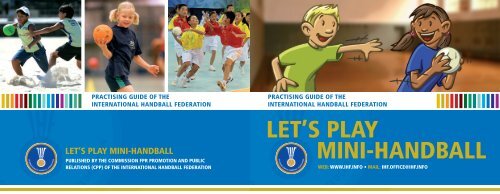

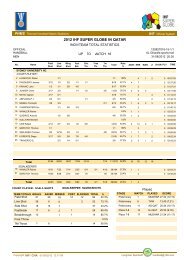
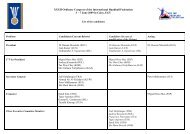
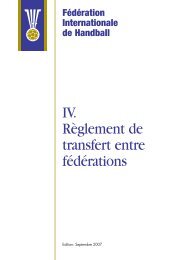
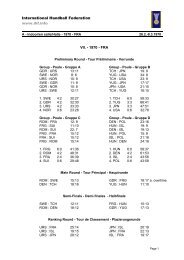
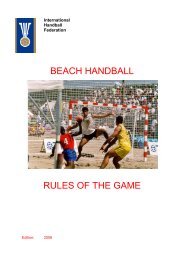
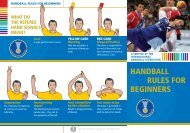
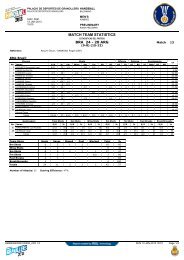

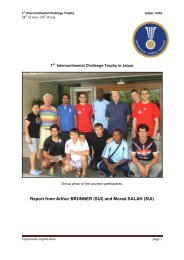
![[IHF- Referee list 2012/2013]](https://img.yumpu.com/18217761/1/184x260/ihf-referee-list-2012-2013.jpg?quality=85)
